Small Growers: 45 years past the revolution
In light of the exciting shift towards small-scale producers, we have organized a tasting event dedicated to experiencing the essence of this revolution firsthand.
Champagne, traditionally known for its celebratory sparkle, has long been synonymous with luxury and festivity. Historically, the region was dominated by large Champagne houses, known as Grandes Marques, which prioritized the creation of a consistent house style. These houses blended wines from various vineyards across the Champagne appellation, often adding substantial amounts of sugar to cater to the tastes of their elite clientele. This approach emphasized branding and marketing over the individual characteristics of vineyards or vintages. As a result, Champagne was largely perceived as a brand-driven, rather than terroir-driven, wine, with individual vineyards and vintages often overshadowed by the pursuit of a uniform product that reflected the house style more than the land's unique qualities.
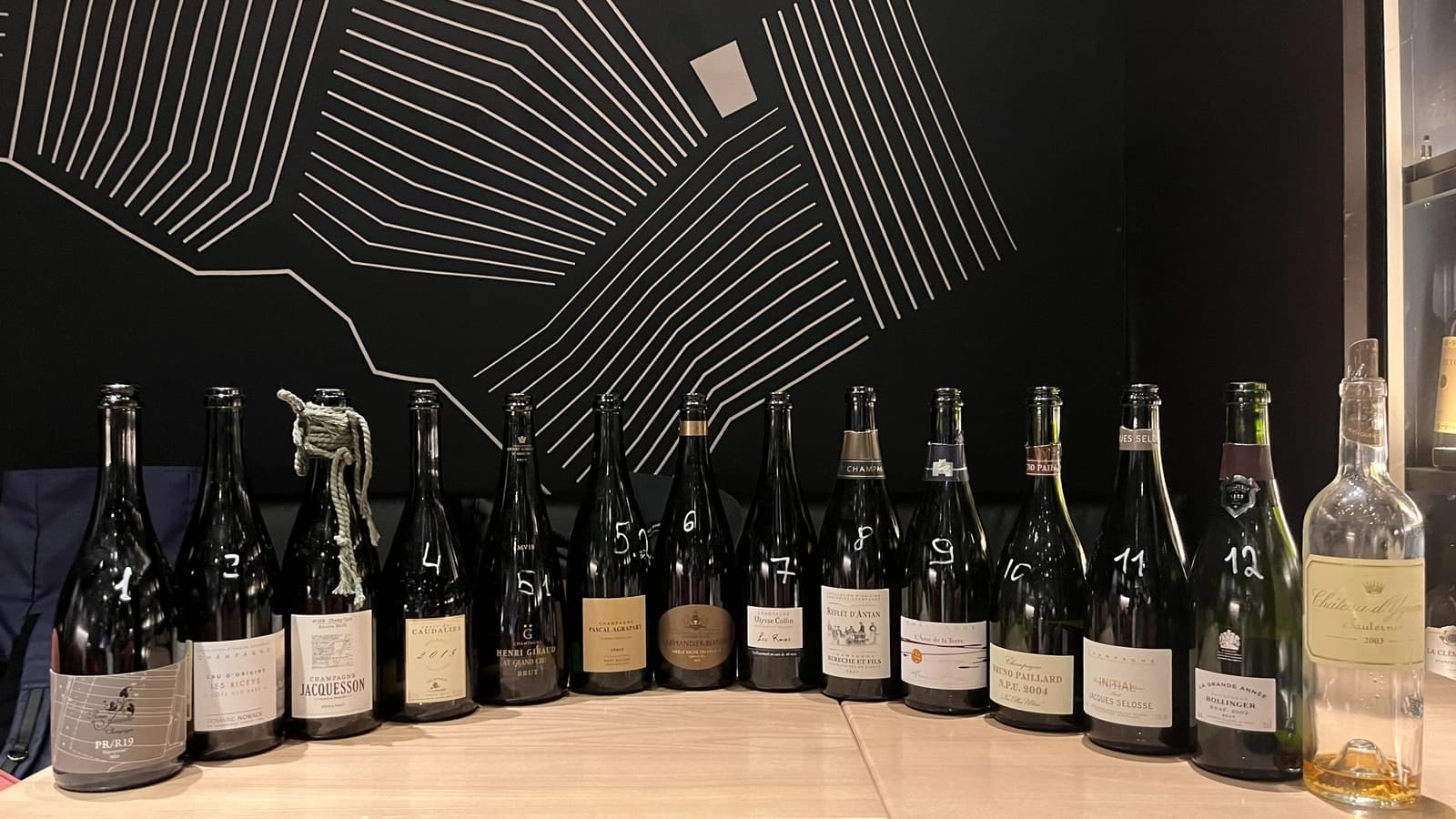
The growers' revolution in Champagne marked a significant shift from this brand-centric approach to a renewed focus on terroir and individual expression. Sparked by influential vignerons like Anselme Selosse, this movement saw small-scale producers, often referred to as "grower Champagnes," prioritizing the unique characteristics of their specific vineyards. These growers championed practices such as reduced yields, organic and biodynamic farming, and fermentation in wooden barrels, drawing inspiration from Burgundian winemaking techniques. This approach allowed the distinct personality of each plot of land to shine through in the wines, celebrating the diversity of Champagne's terroir rather than masking it. As a result, grower Champagnes often showcase a more vinous, complex, and varied profile compared to the more uniform style of the Grandes Marques, offering a more kaleidoscopic view of what Champagne can be.
In light of this exciting shift, we have organized a tasting event dedicated to experiencing the essence of this revolution firsthand. Featuring producers like Selosse, Paillard, and others who embody the spirit of the grower revolution, this event promises to be an exploration of Champagne's new era. This gathering is not just a tasting; it's a journey through the very heart of Champagne's transformation, where each sip reveals the depth, complexity, and individuality brought forth by these remarkable vignerons.
Roses De Jeanne Presle PR/R19 2019
- Region
- France » Champagne » Champagne AOC » Côte des Bar
- Type
- white traditional sparkling, brut
- Producer
- Wine
- Vintage
- 2019
- Disgorged
- 2023
- On lees
- 36 months
- Grapes
- Pinot Noir
- Alcohol
- 12.5
- Sugar
- 1
- Volume
- 750 mL
- Find at

This wine secured the 🏅 12th place in our wine tasting lineup.
Roses de Jeanne, established by the visionary Cedric Bouchard in 2000 (after a stint as a sommelier in Paris), represents a paradigm shift in the traditional approach to Champagne production. Taking over his father's vines in the Côte des Bar in the late 1990s, Bouchard embarked on a path that diverged significantly from conventional Champagne methods, embracing a philosophy of single-vineyard, single-variety, single-vintage, and zero-dosage Champagnes.
Bouchard's approach to viticulture is rooted in organic farming, placing a strong emphasis on dramatically reduced yields to maximize quality. This focus on optimal ripeness extends to his meticulous attention in the cellar. Only juice from the first pressing is used, and all fermentations are carried out with indigenous yeast. A long, slow, and cool second fermentation is employed to create smaller, finer bubbles, enhancing the vinosity and precision of his Champagnes.
Initially beginning with just 1.37 hectares in the village of Celles-sur-Ource, Bouchard's philosophy breaks away from the norm of blending different vineyards and vintages, instead focusing on expressing the character of each vintage and vineyard. Bouchard's lineup of Champagnes under the Roses de Jeanne label is a reflection of his commitment to showcasing the unique terroir of each parcel. His portfolio includes (but is not limited by):
- Val Vilaine: 100% Pinot Noir from the lieu-dit of Val Vilaine, producing 300-500 cases annually.
- Côte de Bachelin [La Parcelle]: 100% Pinot Noir from Côte de Bachelin, with a three-year lees ageing, producing 150 cases annually.
- Les Ursules: 100% Pinot Noir from Les Ursules, with the first vintage released in 2014, producing 250-300 cases annually.
- Haute-Lemblée: 100% Chardonnay from La Haute Lemblée, an extremely limited production.
- Bolorée: Rare Pinot Blanc from La Boloree, highly cherished and extremely limited in production.
- Creux d’Enfer Rosé: 100% Pinot Noir from Le Creux d'Enfer, produced using the saignée method, extremely limited in production.
Bouchard's Champagnes are distinguished by their soil-driven personalities, with the terroir of each parcel vividly expressed in every bottle. These wines are the creations of a young, perfectionist vigneron who is poised to revolutionize the landscape of Champagne. Bouchard recommends decanting his Champagnes gently to fully appreciate their unique character and complexity.
This wine is derived from a 0.25-hectare vineyard, consisting of 15 rows of co-planted Burgundian Pinot clones, all selected through massale propagation in 2007. The soil is a rich blend of clay and limestone, interspersed with Kimmeridgian bands, akin to those found in Chablis and Chavignol, lending a unique mineral profile. The vineyard is maintained through organic practices. The production involves only the first press of hand-harvested grapes, which are then foot-crushed, ensuring a gentle extraction. Fermentation occurs naturally with indigenous yeasts in stainless steel tanks, preserving the wine's authentic expression. It is then bottled unfined and unfiltered, retaining its natural essence. The wine undergoes a lengthy 36-month aging sur lie, adding complexity without any dosage, to enhance its purity and texture.
Domaine Nowack Les Riceys 2015
- Region
- France » Champagne » Champagne AOC
- Type
- white traditional sparkling, extra brut
- Producer
- Wine
- Vintage
- 2015
- Disgorged
- 2022-03
- On lees
- 72 months
- Grapes
- Pinot Noir
- Alcohol
- 12
- Sugar
- 2.2
- Volume
- 750 mL
- Find at
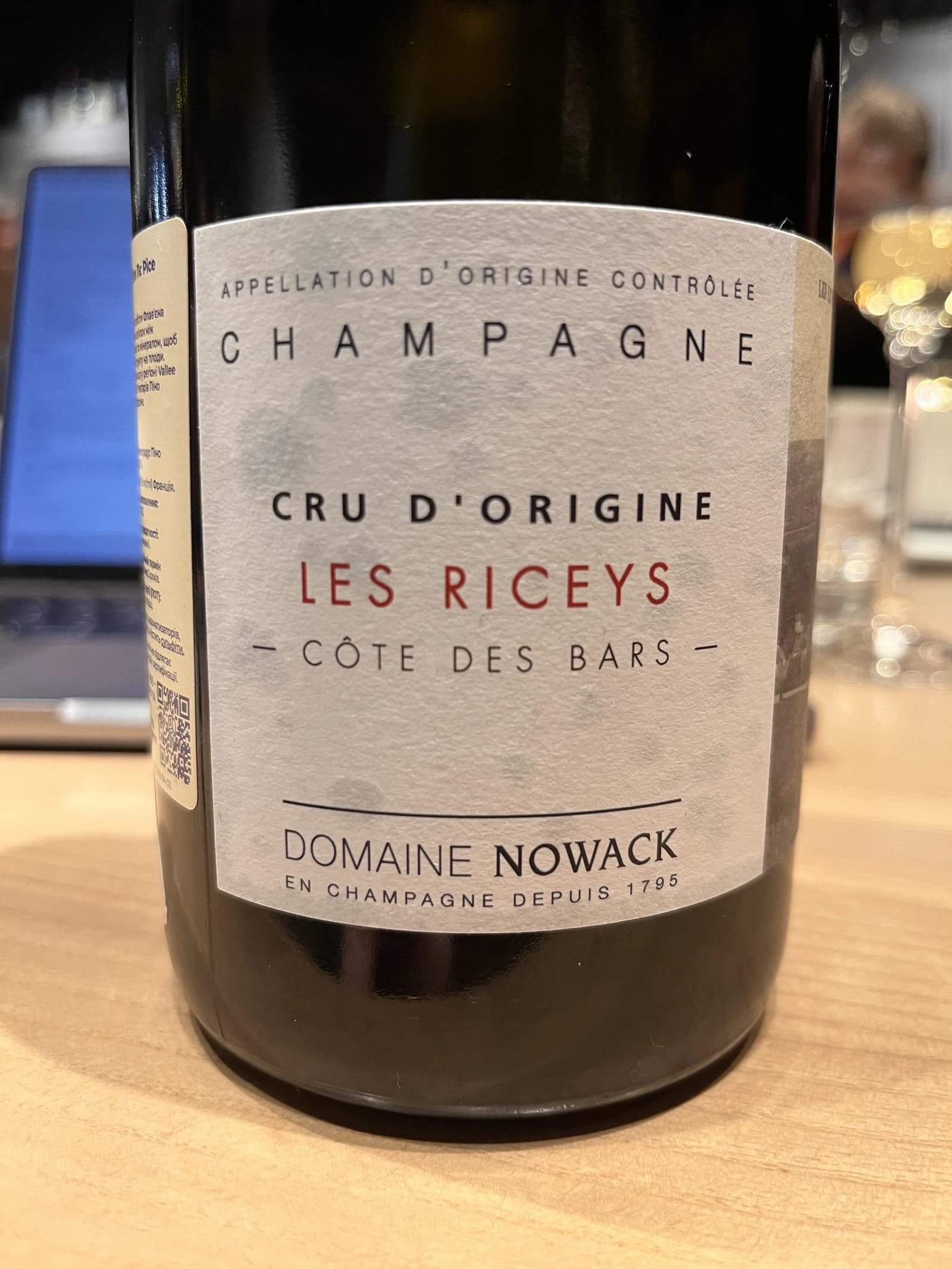
This wine secured the 🏅 14th place in our wine tasting lineup.
Domaine Nowack, situated in Vandières in the Vallée de la Marne, has emerged as a beacon of innovation and quality in the Champagne region under the guidance of Flavien Nowack. Since joining his family's domaine in 2011, Flavien has been a part of a movement towards single-vineyard, single-variety, and single-vintage Champagne production, underscoring a commitment to expressing the distinct terroir of Vandières.
Embracing organic farming practices and harvesting grapes only at full maturity, Flavien initially produced three Champagnes from 3 hectares provided by his father. His early ambition was to showcase the differences between Meunier, Pinot Noir, and Chardonnay from three single parcels, all situated at the same elevation within Vandières. This innovative approach highlights the distinct characteristics of each varietal when grown in the same terroir.
His non-interventionist approach in the vineyard and the cellar, including avoiding chaptalization and malolactic fermentation, underscores the purity and delicate nature of his Champagnes. He relies on the natural yeast from unfermented grape must for the secondary fermentation in the bottle, further emphasizing the wine's vinous characteristics. He bottles his Champagnes under lower pressure, which contributes to their unique, vinous quality.
Jacquesson Avize Champ Caïn 2013
- Region
- France » Champagne » Champagne AOC » Côte des Blancs » Avize
- Type
- white traditional sparkling, extra brut
- Producer
- Wine
- Vintage
- 2013
- Disgorged
- 2022-04
- On lees
- 96 months
- Grapes
- Chardonnay
- Alcohol
- 12.5
- Sugar
- 1.5
- Volume
- 750 mL
- Find at
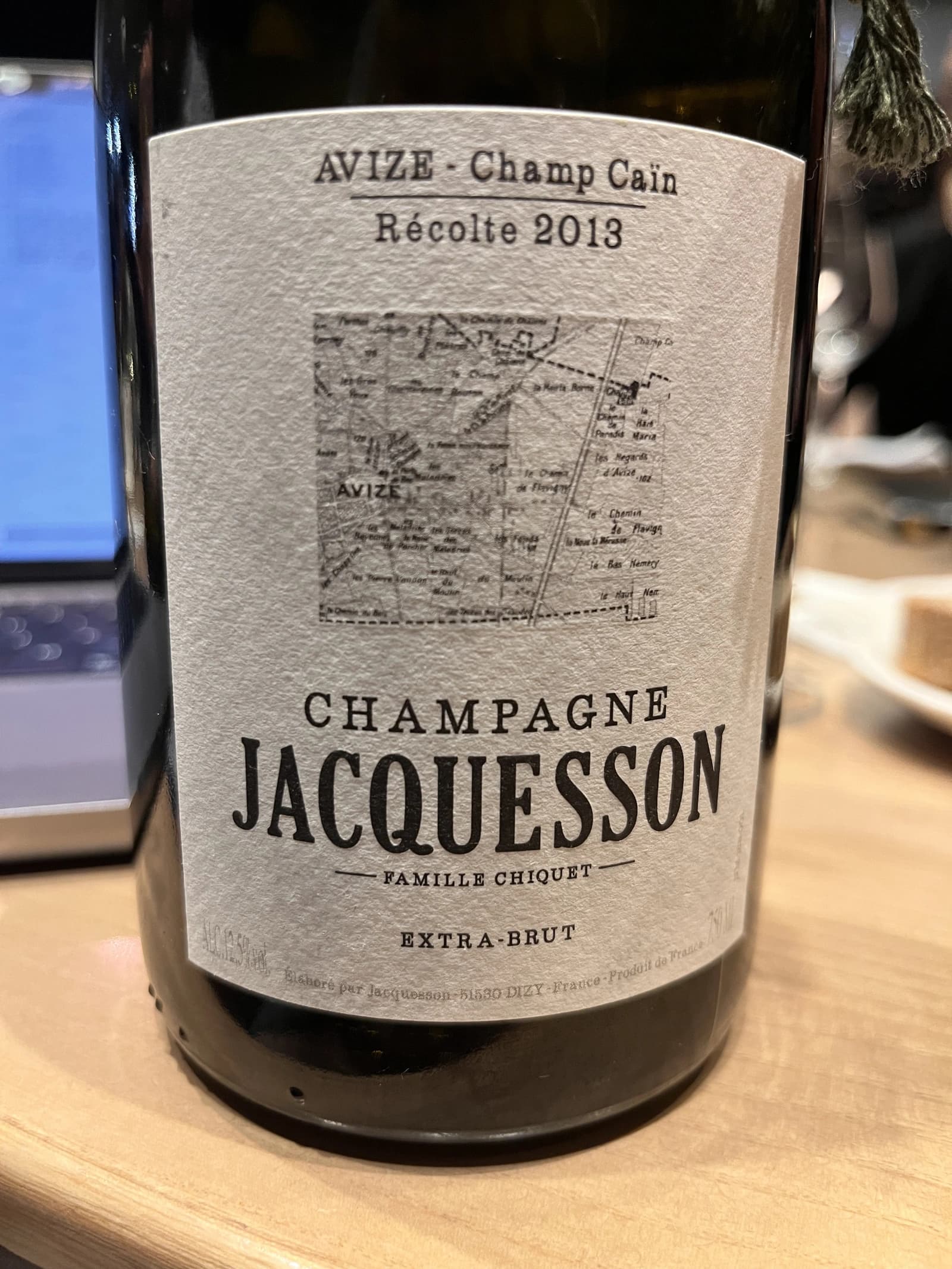
This wine secured the 🏅 13th place in our wine tasting lineup.
Jacquesson, one of the most venerable houses in the Champagne region, has undergone a revolutionary transformation under the leadership of the Laurent and Jean-Hervé Chiquet brothers. Since taking over from their father in the 1990s, the Chiquets have steered Jacquesson away from conventional winemaking practices, embracing a terroir-based, herbicide-free philosophy. Their groundbreaking decision to retire the house's 150-year-old non-vintage blend in favour of a single-vintage-based cuvée was a bold move that marked a departure from Champagne's tradition of striving for a consistent house style. These change not only reflects Jacquesson's commitment to quality and terroir but also signifies their willingness to embrace the unique characteristics of each vintage.
Jacquesson's approach to winemaking is characterized by a focus on expressing the unique qualities of each vintage, a philosophy that diverges from the norm in Champagne, which focuses on producing consistent wine each year. The Chiquets' decision to prioritize expression over consistency is evident in their numbered cuvées, starting with 728 based on the 2000 vintage. Each cuvée is a reflection of the year's harvest, with blends changing annually yet consistently showcasing a mix of Chardonnay, Pinot Noir, and Pinot Meunier. The winemaking process remains constant, featuring vinification in large old oak barrels, ageing on lees with weekly bâtonnage, minimal dosage, and no filtration. This method has garnered widespread acclaim for its transparency and remarkable minerality, highlighting Jacquesson's commitment to quality and innovation.
In addition to the 700 Series, Jacquesson produces limited quantities of single-vineyard cuvées, each representing a unique parcel of vines. These Champagnes, lauded for their extraordinary expression of terroir, are made from small plots in Dizy, Avize and Aÿ. Jacquesson is also renowned for its late-disgorged older vintages, distinguished by their elaborate Baroque labels reminiscent of the 1840s. This aspect of Jacquesson's production underscores the house's devotion to crafting Champagnes that are not just excellent but also historically resonant and deeply connected to their heritage.
Like it wasn't enough, Laurent and Jean-Hervé Chiquet brought one more novelty to the Champagne landscape. All wines of the 700 Series (in spite of Grand Crus and Mlllésimes they used to produce before 2000) come in two versions - regular and late disgorgement, with around 3 and 7-8 years on fine lees. This gives a unique chance to compare wine development on lees and post-disgorgement.
Since its establishment in 1798 by Memmie Jacquesson, the house of Jacquesson has traversed a fascinating journey. Initially basking in the glory of Emperor Napoleon's gold medal endorsement in 1810, the house experienced a period of decline before being sold in the late 19th century. Intriguingly, it was in 1843 that Johann-Joseph Krug departed Jacquesson to establish his own now-famous Champagne house. A pivotal turn for Jacquesson arrived with its acquisition by Jean Chiquet in 1974, who later passed the reins to his sons. Fast forward to 2022, and Jacquesson entered a new chapter under the stewardship of François Pinault's Artémis Domaines, part of the Groupe Artémis conglomerate, which also encompasses esteemed entities like Christie’s auction house, and luxury brands Gucci and Balenciaga. Furthermore, Artémis Domaines manages Château Latour and an exclusive selection of premier wine estates across France and California. Today, Jacquesson stands as a distinguished member of a modern French empire, one synonymous with the pinnacle of luxury.
[…] Jacquesson’s small size as a maison producing 250,000 bottles per year, its strong vigneron culture and its image as "champagne for the wine connoisseur" are all elements very much aligned with our philosophy at Artémis Domaines and are very compatible with our other domaines.
De Sousa Cuvée des Caudalies Grand Cru 2013
- Region
- France » Champagne » Champagne AOC » Côte des Blancs
- Type
- white traditional sparkling, extra brut
- Producer
- Vintage
- 2013
- Disgorged
- 2022-03-28
- On lees
- ~92 months
- Grapes
- Chardonnay
- Alcohol
- 12.5
- Sugar
- 3
- Volume
- 750 mL
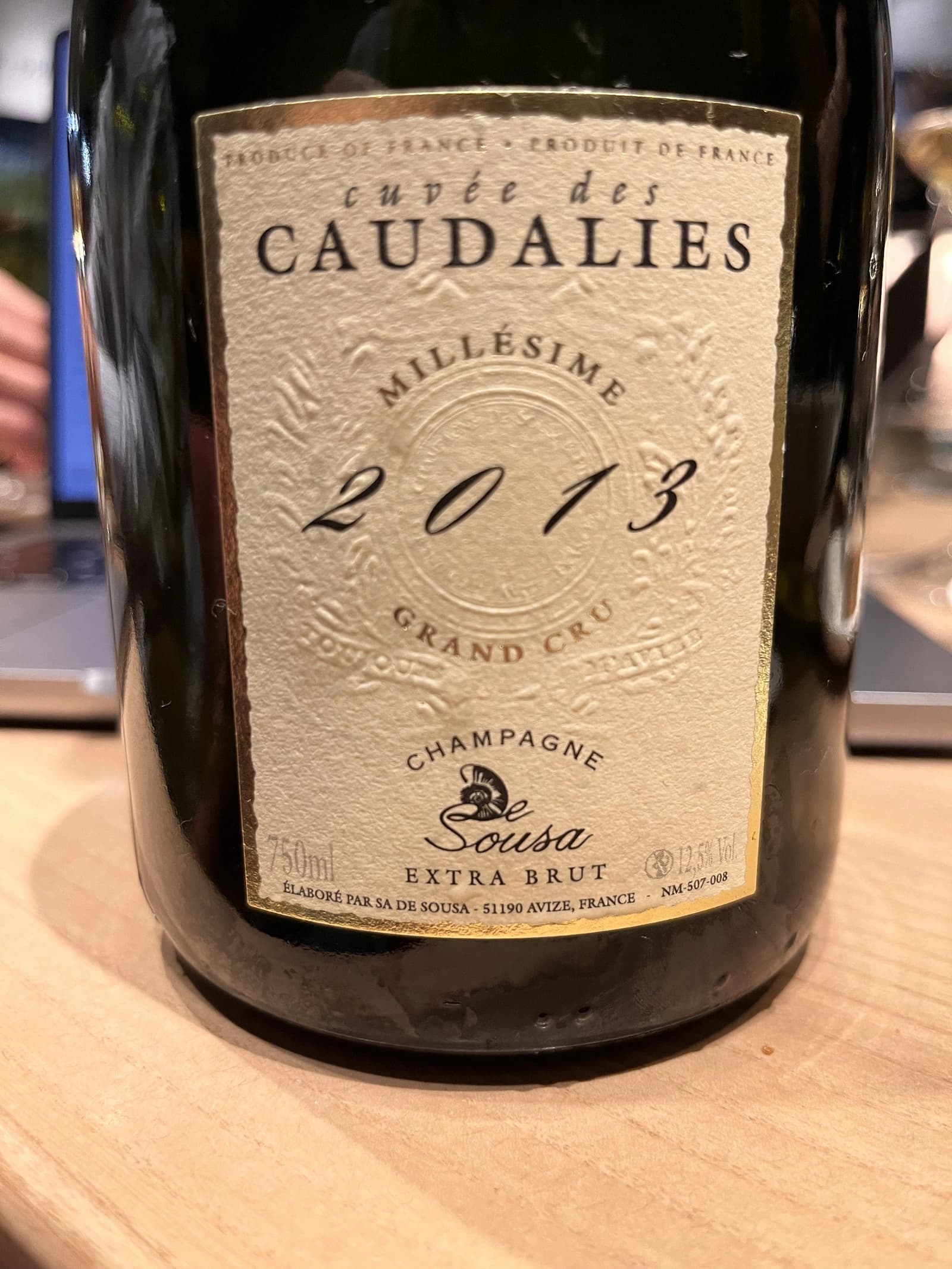
This wine secured the 🏅 10th place in our wine tasting lineup.
Champagne De Sousa, with its roots firmly planted in the historic vineyards of the Côte des Blancs, embodies a legacy that spans over half a century. The family's deep connection to the land and commitment to sustainable viticulture are evident in every aspect of their winemaking. Erick De Sousa, taking over the reins, has been a transformative figure, integrating the family's ingrained values of soil respect, work ethic, and innovation into a modern vision for the domaine.
Nestled in the renowned Grand Cru villages of Avize, Cramant, and Oger, Champagne De Sousa has established itself as a producer of exceptional quality. The vineyards, some of the oldest in the Côte des Blancs, are cultivated with a focus on organic farming. This approach, certified in Organic Farming since 2010 and Demeter since 2013, reflects Erick De Sousa's philosophy of nurturing the vines to express the unique characteristics of their terroir.
The vines of De Sousa, with their deep-rooted "pivots," delve into the chalky soils up to 12 meters deep. This profound rooting system allows the vines to absorb a rich array of minerals and trace elements, imparting a distinct minerality and complexity to the grapes. The deeper rooting also distances the vines from surface-level fertilizers, ensuring a natural intake of nutrients and guaranteeing the quality of the grapes.
The De Sousa vineyard, established before 1890, spans 11 hectares and consists of 42 different lots, all resting on 100% chalk geology. The vineyard composition reflects a thoughtful balance of grape varieties: 30% Pinot Noir, 10% Pinot Meunier, and 60% Chardonnay, with an average vine age of over 45 years. The domaine's approach to pruning, including Chablis and Cordon de Royat methods, along with a careful yield management strategy, ensures the health and vitality of the vines.
In the cellar, Erick De Sousa's commitment to capturing the essence of each parcel is evident. The winemaking process respects the natural characteristics of the grapes, with vinification in coated steel vats and small oak barrels for older vines. This method enhances the wine's complexity while preserving the soil's authenticity. Fermentation is carefully controlled at 18°C, and indigenous yeasts are used to maintain the wine's unique profile. The wines are bottled without filtration, and remuage (riddling) is performed manually, adding to the meticulous nature of the production process.
The De Sousa family's history is interwoven with the vineyards themselves. From Manuel, Erick's Portuguese grandfather who settled in Avize after the harrowing experiences of World War I, to Erick's father, a prisoner of war during World War II, their stories of resilience and connection to the land are integral to the domaine's identity. This history is not merely a backdrop but a driving force that inspires their approach to winemaking.
Today, Champagne De Sousa is renowned for its minerally driven, complex, and nuanced Champagnes, a direct result of the family's dedication to expressing the terroir's unique qualities. Erick De Sousa's visionary approach, coupled with a deep respect for tradition and the environment, positions Champagne De Sousa as a distinguished producer, crafting wines that are not only a reflection of their prestigious terroir but also a tribute to the family's enduring legacy in the Côte des Blancs.
Henri Giraud MV18 NV
- Region
- France » Champagne » Champagne AOC
- Type
- white traditional sparkling, brut
- Producer
- Wine
- Vintage
- NV, based on 2018
- Disgorged
- N/A
- On lees
- N/A
- Grapes
- Chardonnay, Pinot Noir
- Alcohol
- 12
- Sugar
- 5.1
- Volume
- 750 mL
- Find at
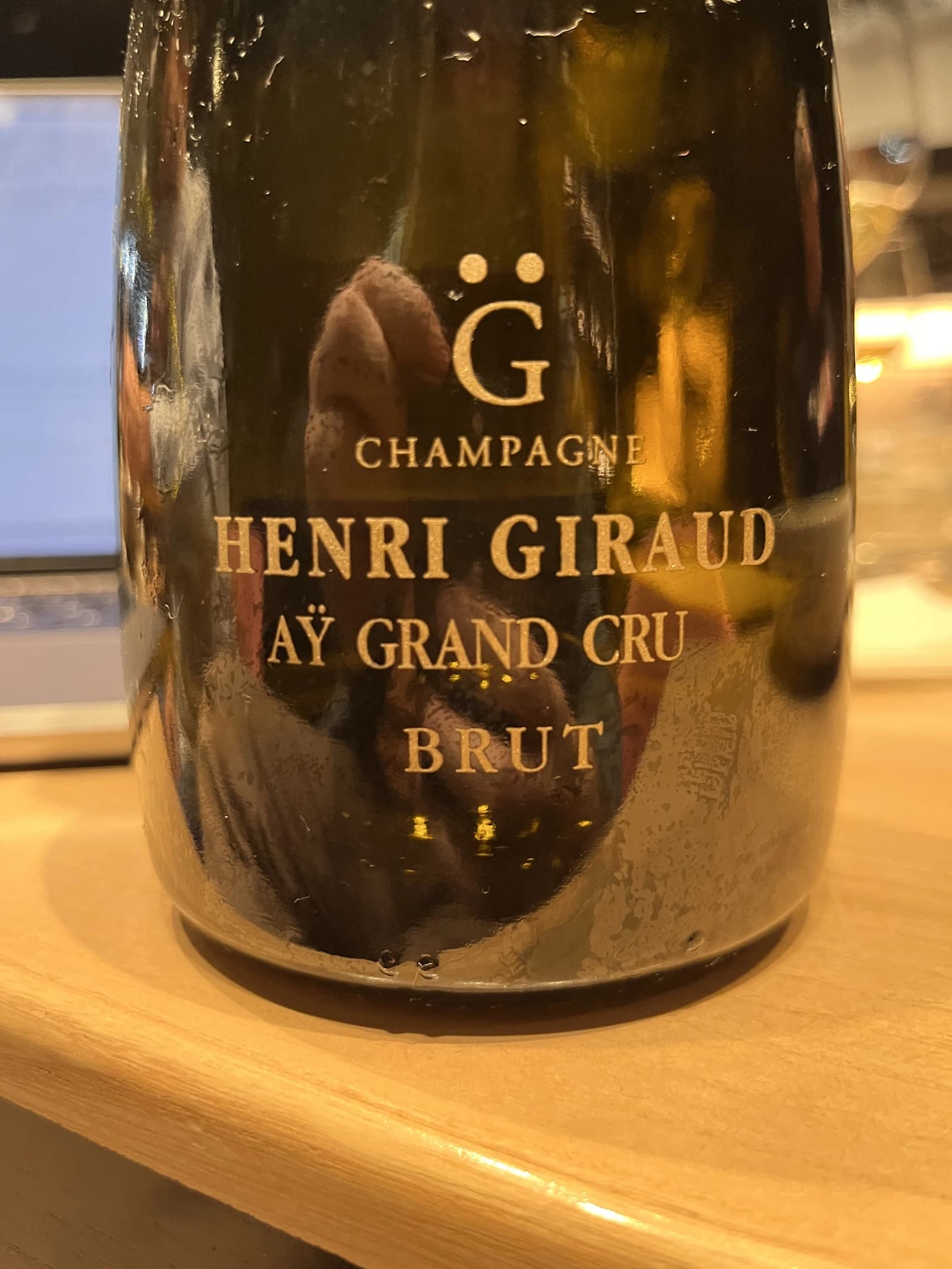
This wine secured the 🏅 11th place in our wine tasting lineup.
Champagne Henri Giraud, under the stewardship of Claude Giraud, represents a fusion of deep historical roots and innovative winemaking in the prestigious Champagne region. The Giraud family, with a lineage tracing back to the early 17th century, has been an integral part of the Aÿ terroir, a Grand Cru village that has long been synonymous with the highest quality Champagne.
The Giraud family's connection to Aÿ, a village whose wines have been celebrated for centuries and favoured by French kings, is profound. The historical significance of Aÿ in the Champagne region is notable; until 1887, Champagnes were often referred to as "wines of Aÿ," underscoring the village's importance. Today, Aÿ remains a Grand Cru village, a designation that speaks to the exceptional quality and unique character of its terroir.
Champagne Henri Giraud has a storied history that dates back to 1625. The Hémart family, ancestors of the current Giraud family, established themselves in Aÿ in the 17th century. Their story weaves through the fabric of Champagne's history, surviving and rebuilding through challenges like phylloxera and the First World War. Léon Giraud, who married into the Hémart family in the early 20th century, played a pivotal role in reviving the family's vineyards after these calamities.
Claude Giraud, representing the 12th generation of the Giraud-Hémart family, continues this legacy with a commitment to tradition and innovation. He has been instrumental in reviving the use of Argonne oak barrels for ageing Champagne, a practice that dates back centuries. This return to traditional methods has led to the creation of the house's iconic cuvée, "Argonne," which is celebrated for its exceptional quality.
The house's expertise extends beyond oak ageing to include experimentation with terracotta and sandstone containers, optimizing the interaction between the wine and its lees. This innovative approach contributes to the distinctive saltiness, intensity, and aromatic complexity that characterize Champagne Henri Giraud's offerings.
With a limited production of 250,000 bottles annually, including only a few thousand bottles of their grand cuvées, Champagne Henri Giraud's offerings are highly sought after by collectors and connoisseurs worldwide. This exclusivity is a testament to their commitment to quality and the unique expression of their terroir.
The Giraud family's philosophy, "Let nothing be banned and nothing be obligatory – just make good wine naturally," reflects their approach to winemaking. This ethos, coupled with their sustainable viticulture practices and certification of high environmental value (HVE), highlights their dedication to both quality and environmental stewardship.
In summary, Champagne Henri Giraud exemplifies the fusion of historical legacy and modern innovation in Champagne. Their deep roots in the prestigious Grand Cru village of Aÿ, combined with their commitment to quality and sustainable practices, continue to position them as a beacon of excellence in the Champagne region.
Agrapart Vénus 2014
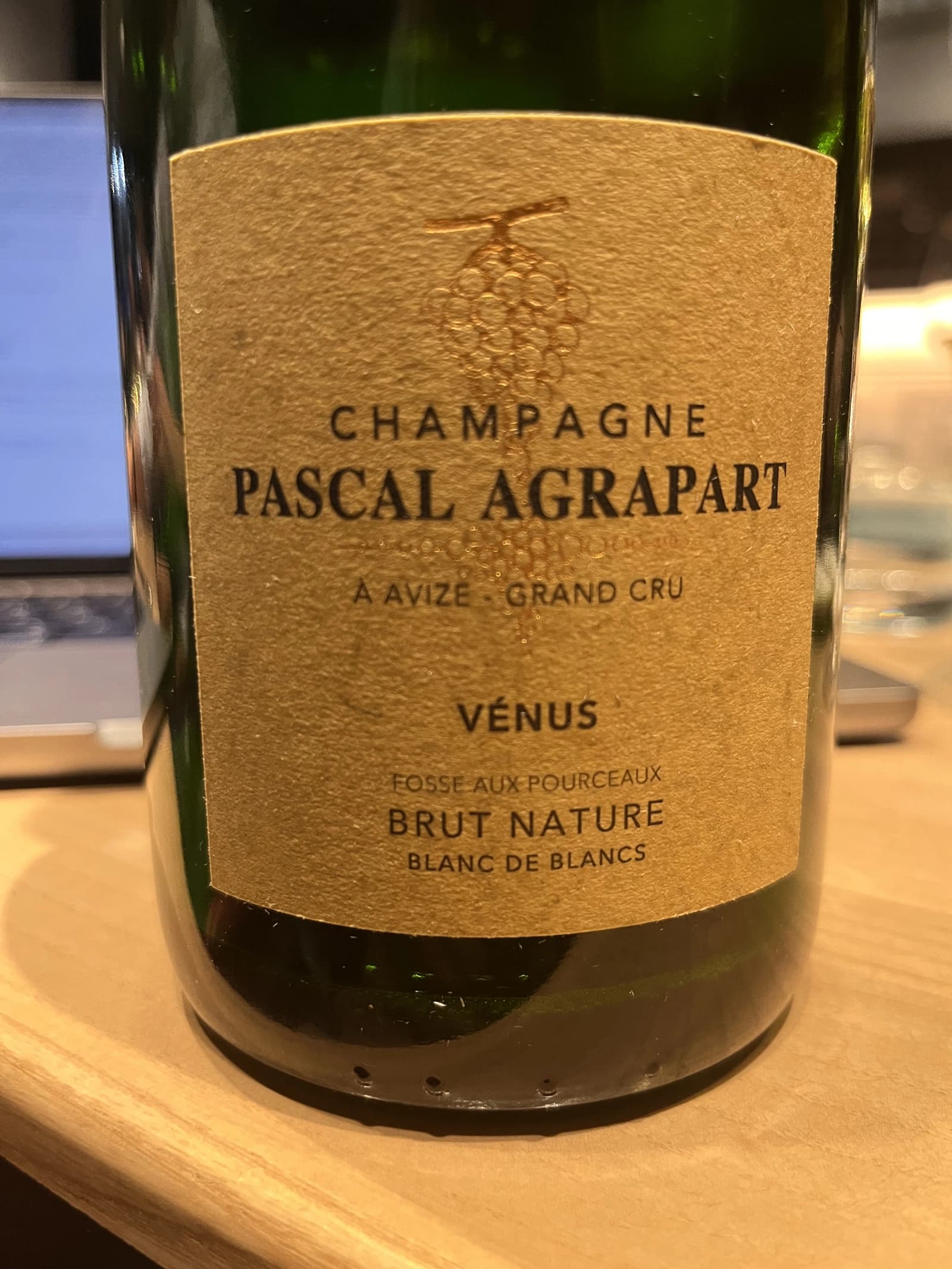
This wine secured the 🏅 4th place in our wine tasting lineup.
Agrapart et Fils, led by the fourth-generation vigneron Pascal Agrapart, exemplifies the fusion of traditional craftsmanship and innovative winemaking in the heart of Champagne's Côte de Blancs. Based in the village of Avize, Pascal, along with his brother Fabrice, has transformed this historic family domaine into a beacon of quality and complexity in the Champagne region.
Established in 1894 by Arthur Agrapart, the domaine has a long-standing tradition of estate bottling, a practice that predates many of the smaller grower Champagne houses. Pascal Agrapart, known for his humility and expertise, has been instrumental in shaping the domaine's reputation for producing some of the most refined and complex Champagnes in the region.
Pascal's approach to viticulture is deeply rooted in respect for the land and the vines. The vineyards, some over 70 years old, are farmed organically, a practice that Pascal views not as a marketing tool but as the correct way to farm. This dedication to organic farming is reflected in the exceptional quality of the grapes, which are predominantly Chardonnay, from the Grand Cru vineyards in the Côte de Blancs, primarily in Avize, Oger, Cramant, and Oiry.
In the cellar, Pascal's talents as a winemaker shine through. He employs indigenous yeasts for fermentation and adopts a low-intervention approach to preserve the natural character of the wines. Each parcel is vinified separately in used 600-litre barrels, and the wines are finished with minimal dosage to highlight their terroir-driven profiles.
The Agrapart range includes several distinctive cuvées, each reflecting the unique terroirs of Avize. These include the "Les 7 Crus," a blend of Chardonnay and Pinot Noir from Premier and Grand Cru vineyards, and "Terroirs," a pure expression of Grand Cru Chardonnay. The vintage-dated "Parcellaires" cuvées – "Minéral," "L’Avizoise," and "Vénus" – each capture the essence of different parts of the Avize hillside, showcasing the influence of chalky limestone and clay on the wines.
In addition to these, Agrapart produces two micro-cuvées: "Complantée," a blend of six varieties from Avize, and "Expérience," a unique cuvée made without any added yeast, sugar, or dosage. "Expérience" is a testament to Pascal's innovative spirit, only produced when conditions allow for this natural method of secondary fermentation.
Agrapart et Fils' Champagnes are renowned for their purity, elegance, and expressive minerality, making them highly sought after by connoisseurs and collectors. Pascal Agrapart's dedication to expressing the terroirs of Avize, combined with his meticulous approach in both the vineyard and cellar, has rightfully placed Agrapart et Fils among the elite producers in Champagne, continuing to inspire and lead in the region's ongoing quality revolution.
Larmandier-Bernier Vieille Vigne du Levant Grand Cru 2010
- Region
- France » Champagne » Champagne AOC » Côte des Blancs » Cramant
- Type
- white traditional sparkling, extra brut
- Producer
- Vintage
- 2010
- Disgorged
- N/A
- On lees
- >108 months
- Grapes
- Chardonnay
- Alcohol
- 12.5
- Sugar
- 2
- Volume
- 750 mL
- Find at
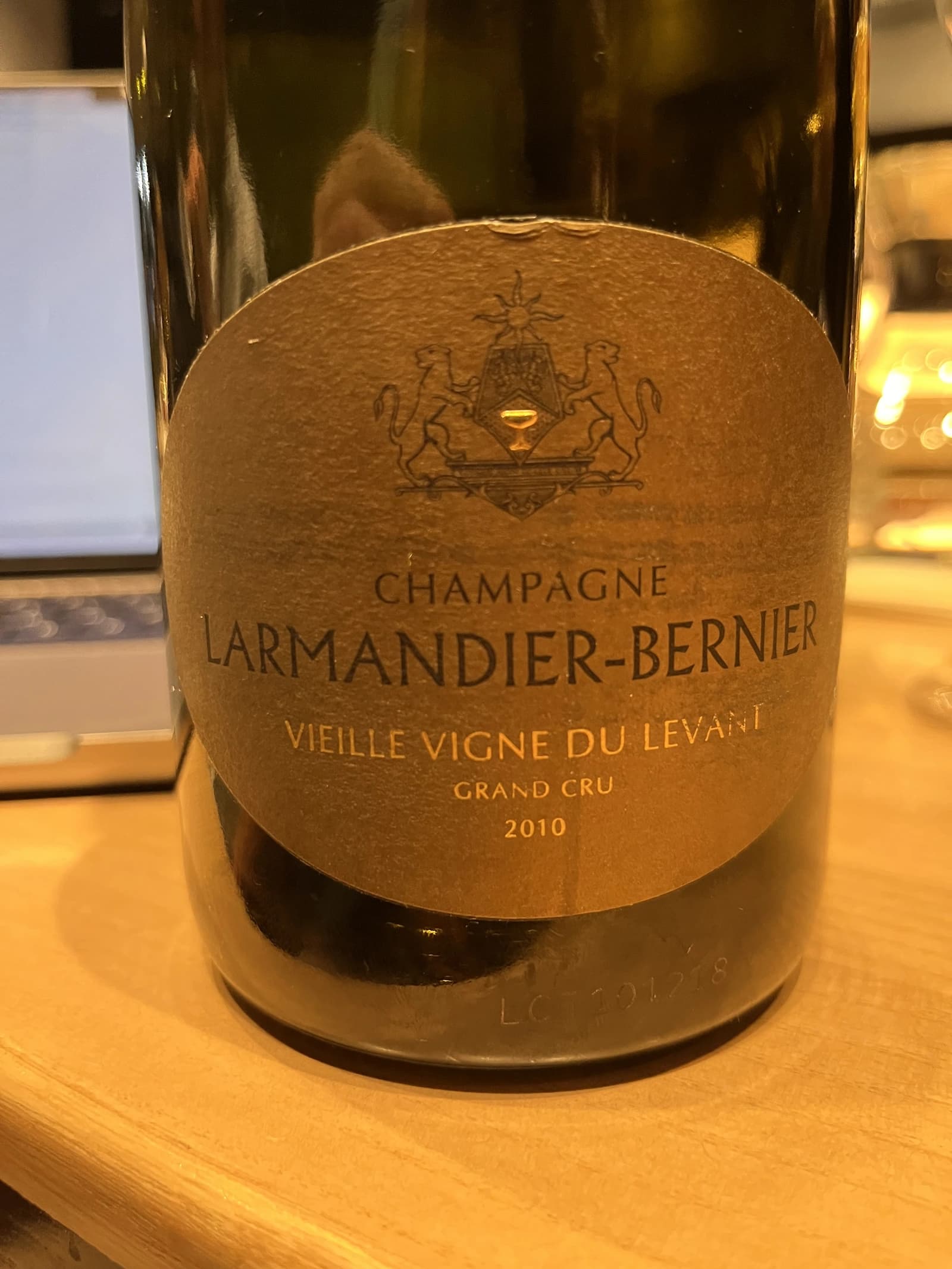
This wine secured the 🏅 8th place in our wine tasting lineup.
Larmandier-Bernier, under the visionary guidance of Pierre Larmandier, stands as a beacon of excellence and innovation in the Champagne region, particularly in the Côte des Blancs. Since assuming control of his family's estate in 1988, Pierre has been at the forefront of biodynamic viticulture in Champagne, championing low yields and mature grape harvesting to achieve a balance of sugars and acidity – a quest that he describes as the holy grail of grape growing.
The estate, with a history intertwined with both the Larmandier and Bernier families dating back to the French Revolution, was officially established in 1971 through the union of Philippe Larmandier and Elisabeth Bernier. Today, the estate, managed by Pierre and Sophie Larmandier and their son Arthur, spans nearly eighteen hectares across some of the most esteemed villages in the Côte des Blancs: Cramant, Chouilly, Oger, and Avize (all Grand Crus), as well as Vertus, a premier cru village.
Pierre's approach to viticulture is deeply rooted in organic and biodynamic principles, having transitioned to these practices by 1999. The estate is predominantly planted with Chardonnay, complemented by smaller proportions of Pinot Noir and Pinot Gris. The Larmandiers' commitment to quality is evident in their conservative approach to yields, especially as their vines approach 50 years of age.
In the cellar, Pierre's philosophy continues, with a focus on producing wines that authentically express the unique terroirs of the Côte des Blancs. Indigenous yeasts are used for alcoholic fermentations, and each cru is vinified separately, employing a mix of foudres and Burgundian barrels based on the parcel and vintage characteristics. Malolactic fermentation is allowed, and blending decisions are made in the summer following the harvest, determining whether their single-vineyard bottlings will be produced.
Larmandier-Bernier's Champagnes are characterized by their minimal dosage levels, a decision Pierre believes is "earned in the vineyard." This philosophy results in Extra Brut Champagnes that are notable for their textural purity and underlying energy, reflecting the chalky mineral soils of their terroir. The lineup includes Latitude Blanc de Blancs Extra Brut NV, Longitude Blanc de Blancs Extra Brut 1er Cru NV, Terre de Vertus Bl. de Blancs Non Dosé 1er Cru, Les Chemins d'Avize Extra Brut 1er Cru, Vieille Vigne de Levant Extra Brut GC, and Rosé de Saignée Extra Brut 1er Cru.
Each Champagne in the Larmandier-Bernier portfolio is a testament to the estate's commitment to showcasing the profound potential of low-/no-dosage bottlings, emphasizing the purity, energy, and balance inherent in their exceptional terroir. With impeccable balance and the ability to age gracefully, the Champagnes of Larmandier-Bernier are not only highly regarded but also sought after by connoisseurs and collectors worldwide. They stand as reference points in the Champagne region, embodying the elegance, complexity, and vivacity that define the best of the Côte des Blancs.
Ulysse Collin Les Roises (2015) NV
- Region
- France » Champagne » Champagne AOC » Côte de Sézanne
- Type
- white traditional sparkling, extra brut
- Producer
- Vintage
- NV, based on 2015
- Disgorged
- 2020-03
- On lees
- 48 months
- Grapes
- Chardonnay
- Alcohol
- 12.5
- Sugar
- 2.4
- Volume
- 750 mL
- Find at
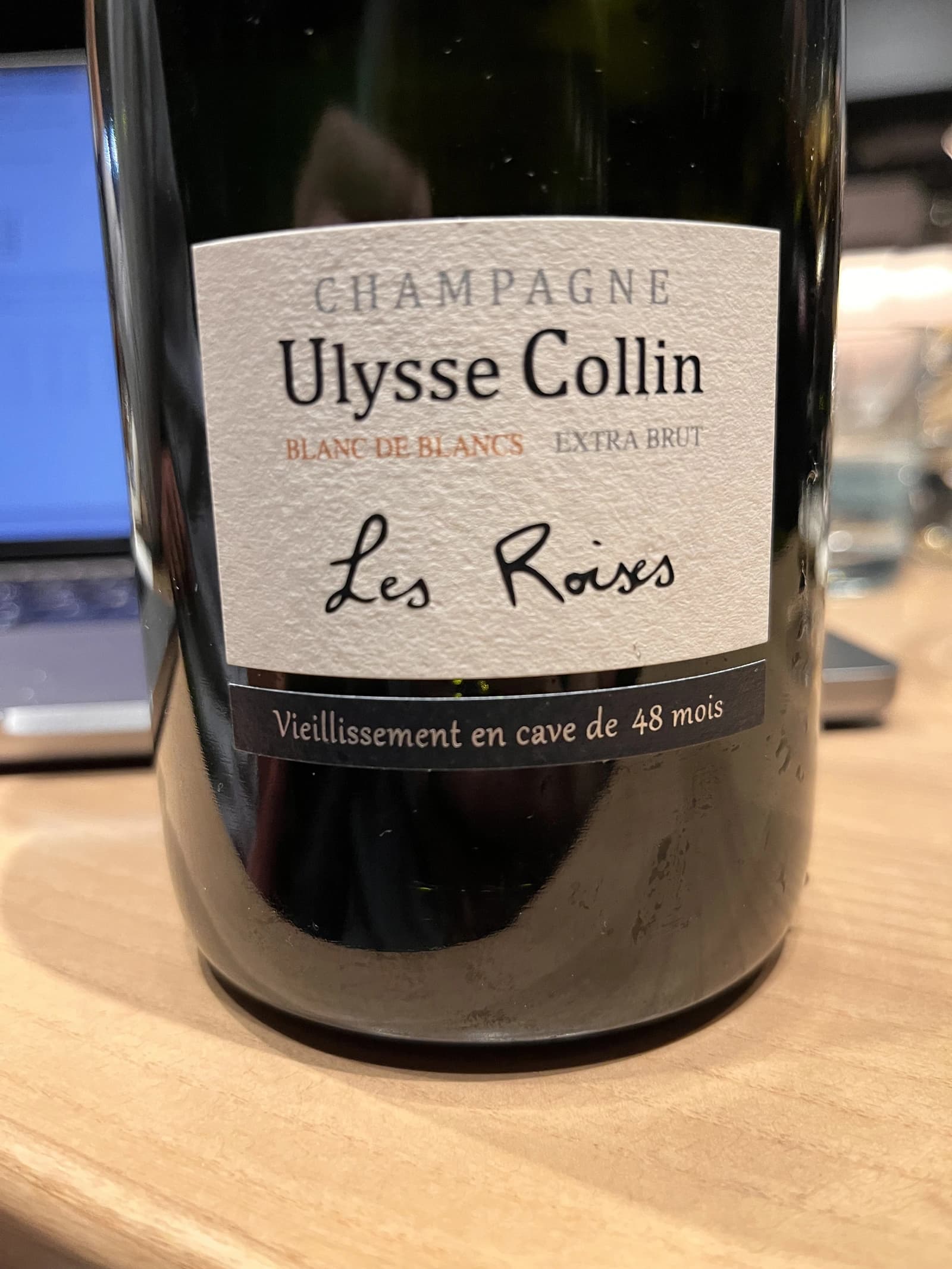
This wine secured the 🥇 1st place in our wine tasting lineup.
Ulysse Collin, a venerated name in the Champagne world, is deeply rooted in the historic vineyards of Congy, located in the Coteaux du Petit Morin. The Collin family has been integral to the vine-growing landscape since 1812, with a lineage of viticulture that spans generations. Olivier Collin, the current custodian of the family's legacy, stands as a pivotal figure in the estate's evolution, particularly noted for his transformative approach to both vineyard management and winemaking.
The Collin family's journey in Champagne has been marked by notable achievements and significant transitions. Georges Collin, the first Récoltant Manipulant in Congy, began his journey in 1930, earning accolades from the French Ministry of Agriculture. This legacy was furthered by René Collin, Olivier's grandfather, who expanded the estate to 18 hectares post-World War II and became a prominent member of the "Club des Viticulteurs Champenois". However, a pivotal change occurred in 1987 when Olivier's father ceased independent wine production, opting instead to rent out the family's vines and cellar to a major Champagne house.
Olivier Collin's path to winemaking was notably influenced by a transformative trip to Burgundy during his university years. Enthralled by the distinct climates and unique wines of the Côte de Beaune, he was inspired to reclaim his family's land and embarked on a legal education to facilitate this goal. His success in this endeavour was evident in 2003 when he reclaimed 4.5 hectares of vineyards that had been leased for a generation.
Starting from scratch, Olivier faced the formidable task of revitalizing soils that had not been ploughed in nearly two decades. His first vintage, 2004, marked a significant milestone, producing Chardonnay from the Les Pierrières plot, renowned for its unique geological composition of shallow topsoil over soft Campanian chalk with carbonated silex or Onyx. This specific terroir, unique to the Coteaux du Petit Morin, imparts a distinctive character to the Ulysse Collin Champagnes.
Olivier Collin's approach to viticulture and winemaking is deeply reflective of his Burgundian influences. He is a pioneer in Champagne for exclusively releasing single-vineyard expressions, a practice that diverges from the region's tradition of multi-parcel, multi-vintage blends. His portfolio includes six distinct wines, each a single-vineyard expression, showcasing the diversity and complexity of his terroirs. These vineyards, including Les Pierrières, Les Maillons, Les Roises, Les Enfers, and others, each contribute uniquely to the Collin Champagne's profile.
In the cellar, Olivier employs a blend of traditional and innovative techniques. He favours old Burgundian barrels for fermentation, allowing for extended ageing and complex aromatic development. His philosophy extends to the blending process, where he skillfully combines vintages to achieve the most nuanced expression of his vineyards. This approach is underpinned by a commitment to minimal intervention, allowing the natural characteristics of the terroir and the vintage to shine through in each bottle.
Olivier Collin's dedication to his craft is evident in his meticulous vineyard management. He eschews the use of herbicides and anti-rot products, relying instead on organic practices to maintain the health and balance of his vines. His approach to dosage in Champagne making is equally thoughtful, using specific measurements to achieve the desired balance and complexity in his wines.
So far, Olivier Collin produces 6 distinct wines (each one from a singe vineyard):
- Blanc de Blancs Les Pierrières (first vintage is 2004);
- Blanc de Blancs Les Roises (first vintage is 2008);
- Blanc de Blancs Les Enfers (first vintage is 2010);
- Blanc de Noirs Les Maillons (first vintage is 2006);
- Rose Les Maillons (first vintage is 2011);
- Jardin d'Ulysse (first vintage is 2015).
In summary, Ulysse Collin, under Olivier's stewardship, represents a fusion of deep respect for tradition and a bold, innovative spirit. His Champagnes are not merely expressions of their varietals but are a testament to the history, geography, and passion that define the Coteaux du Petit Morin. They embody the essence of a region lesser-known yet rich in character, brought to prominence through Olivier's dedication and skill.
Bérêche & Fils Reflet d'Antan (2016) NV
- Region
- France » Champagne » Champagne AOC
- Type
- white traditional sparkling, brut
- Producer
- Vintage
- NV, based on 2016
- Disgorged
- 2020-12
- On lees
- 36 months
- Grapes
- Chardonnay, Pinot Noir, Pinot Meunier
- Alcohol
- 12
- Sugar
- 6
- Volume
- 750 mL

This wine secured the 🥈 2nd place in our wine tasting lineup.
Bérêche et Fils, a distinguished name in the Champagne region, has seen a remarkable transformation under the stewardship of brothers Vincent and Raphaël Bérêche. Since taking the reins of the family-owned House in 2004, the brothers have elevated the Maison to new heights, earning widespread acclaim for their exquisite and sought-after cuvées.
Situated in the Premier Cru village of Ludes in the Montagne de Reims, Bérêche et Fils has a vineyard footprint of 14.8 hectares, predominantly in the Montagne de Reims and the Vallée de la Marne, with notable parcels in the Grand Cru terroir of Cramant in the Côte des Blancs. The estate’s vineyards, primarily composed of old vines, are meticulously managed by Vincent and his team, who employ manual cultivation methods, shunning herbicides and insecticides in favour of an organic approach with restricted yields.
In the cellar, Raphaël Bérêche's meticulousness mirrors his brother's approach in the vineyards. He favours natural, slow vinification and extended maturation, primarily in barrels, avoiding malolactic fermentation to preserve the wine's natural acidity and complexity. A distinct aspect of their winemaking is the use of traditional cork for the second fermentation in the bottle, which imparts a mature and integrated flavour profile, softer effervescence, and richer texture due to controlled oxidation. Their champagnes, bottled without filtration and always hand-disgorged, are lauded for their exceptional vinosity and striking purity.
The Bérêche brothers' conscientious and low-intervention approach from vineyard to cellar has earned them a revered spot in the unofficial Grower Champagne Hall of Fame. They are in the esteemed company of other cult grower producers such as Jacques Selosse, Pascal Agrapart, and Jérôme Prévost. Furthermore, Raphaël's contribution to the grower champagne community is significant, having co-founded the ‘Terres et Vins de Champagne’ growers’ organisation in 2009 with his high-school friend Aurélien Laherte. This collective of passionate growers has played a pivotal role in the Champagne region, with their annual tasting event becoming a crucial platform for Champagne's most important growers' trade event, Le Printemps des Champagnes.
Bérêche et Fils' range of champagnes, from their entry-level cuvées to their flagship offerings, are celebrated for their honest, street-level appeal, offering exceptional value and a captivating charm that competes with, and often surpasses, the most prestigious cuvées in Champagne. Their wines are not just a testament to their skill and dedication but also embody the essence of grower champagnes – wines with a distinct identity, rooted in their terroir, and crafted with a profound respect for nature.
This exquisite wine is cultivated on a 0.60-hectare vineyard with vines over 30 years old. It showcases a blend of Pinot Noir and Chardonnay from the Montagne de Reims (specifically from Ludes 1er Cru, Trépail, and Ormes), and Meunier and Chardonnay from the Vallée de la Marne (Mareuil-le-port). The terroir is characterized by lean, highly chalky soil with prominent chalk outcrops. The blend comprises 30% Chardonnay, 35% Pinot Noir, and 35% Meunier, selectively chosen with two-thirds of the best barrels forming a perpetual reserve maintained across three generations. Vinification involves a slow fermentation process in barrels and small vats, maturing on lees with corking, and an extended 36 months of aging on laths. The wine was disgorged in December 2020, with a dosage of 6 g/L, balancing richness with finesse.
Francoise Bedel L'Âme de la Terre Millésime 2006
- Region
- France » Champagne » Champagne AOC » Vallée de la Marne
- Type
- white traditional sparkling, extra brut
- Producer
- Vintage
- 2006
- Disgorged
- 2021-01
- On lees
- 156 months
- Grapes
- Pinot Meunier, Chardonnay, Pinot Noir
- Alcohol
- 12.5
- Sugar
- 4.65
- Volume
- 750 mL
- Find at
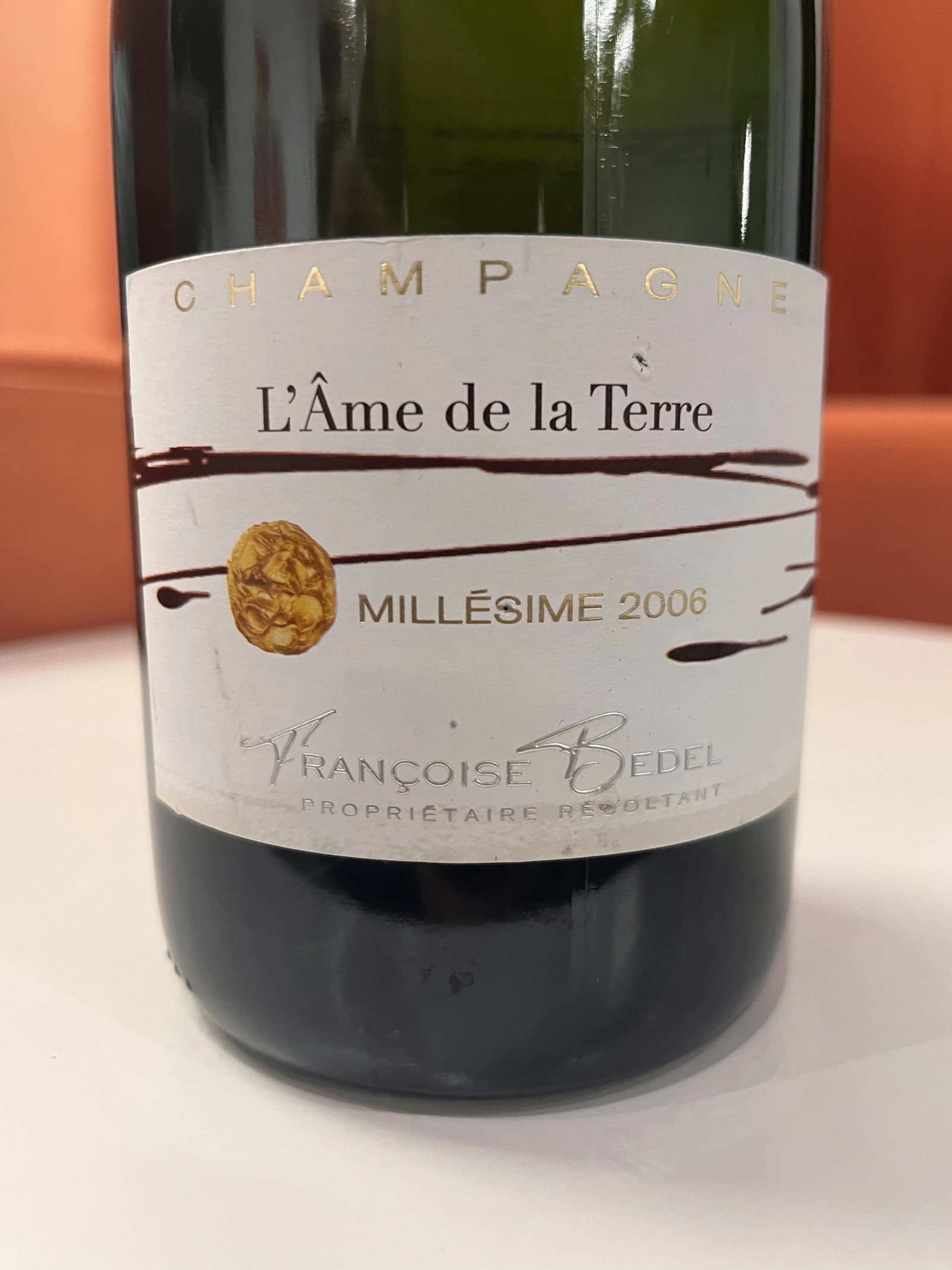
This wine secured the 🏅 6th place in our wine tasting lineup.
Françoise Bedel stands out not only for her remarkable journey into winemaking but also for her unique approach to viticulture and winemaking. Hailing from the village of Crouttes-sur-Marne, located on the western edge of Champagne, Bedel's estate is a testament to her dedication and passion for winemaking. Her journey into biodynamic winemaking, inspired by her personal experiences and a deep reverence for nature, has set her apart in a region celebrated for its long-standing conventional vinegrowing and winemaking traditions.
The 8-hectare estate, cultivated with vines aged between 30 and 60 years, reflects Bedel's commitment to biodynamic practices since 1998. This approach, centred around the interplay between soil, subsoil, and the vine's root system, allows for the fullest expression of the terroir in her grapes. The unique bio-dynamic compost used in the vineyards, containing preparations made from yarrow, chamomile, nettle, oak bark, dandelion, and valerian, is a testament to her dedication to fostering a harmonious relationship between the vineyard and its natural environment.
Located in the Marne Valley, known for its quality Pinot Meunier grapes, Bedel's estate predominantly focuses on this variety, along with smaller plantings of Chardonnay and Pinot Noir. Her Champagnes, often aged for more than six years on the lees, are renowned for their depth and complexity. This extended lees ageing, combined with low or zero dosage, results in Champagnes with significant weight, heft, and lingering acidity.
Bruno Paillard N.P.U. 2004
- Region
- France » Champagne » Champagne AOC
- Type
- white traditional sparkling, extra brut
- Producer
- Wine
- Vintage
- 2004
- Disgorged
- 2017-09
- On lees
- 144 months
- Grapes
- Pinot Noir, Chardonnay
- Alcohol
- 12
- Sugar
- 6
- Volume
- 750 mL
- Find at
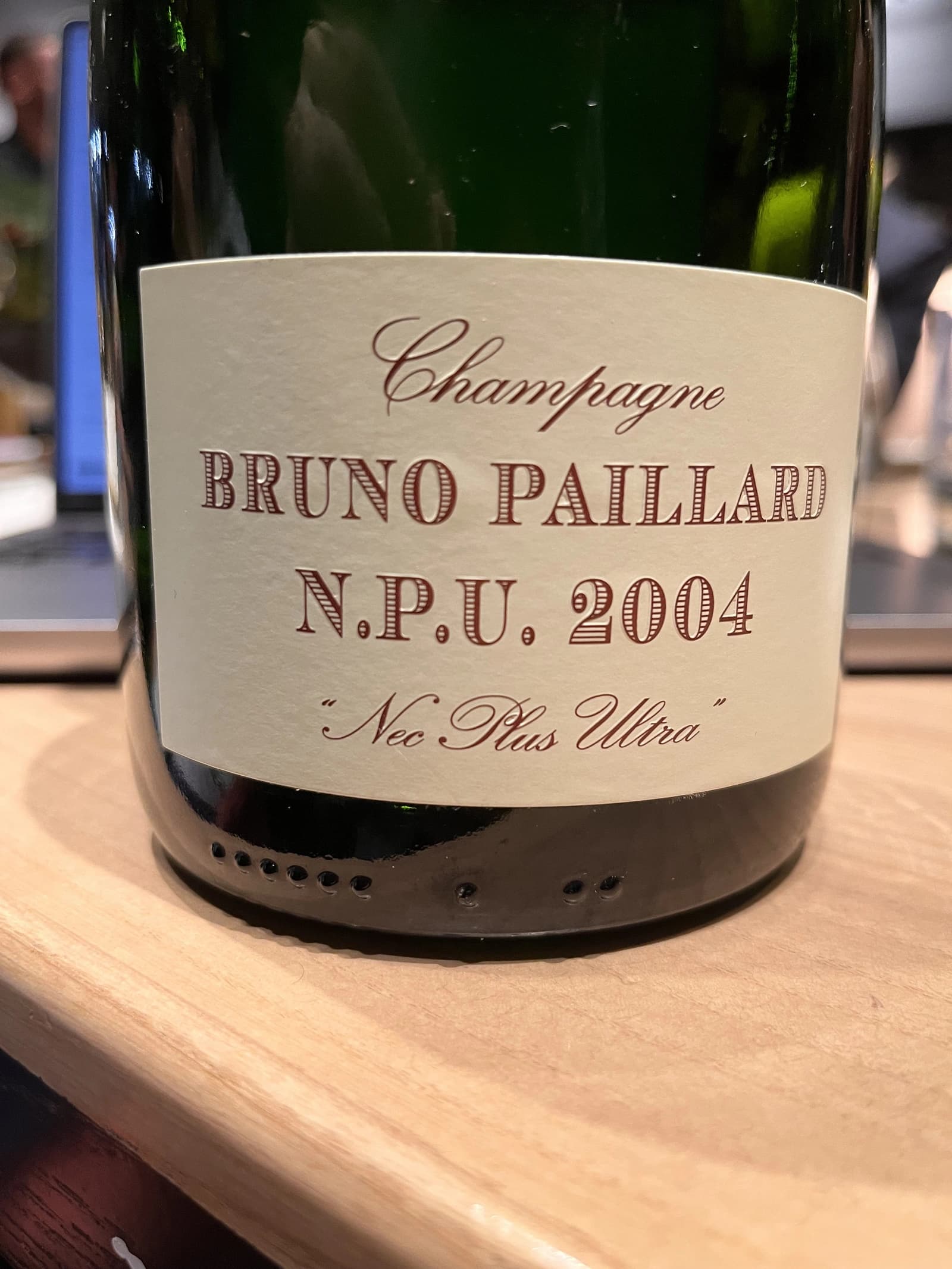
This wine secured the 🏅 5th place in our wine tasting lineup.
Champagne Bruno Paillard, nestled in the Champagne region's heart in Reims, stands as a testament to the dedication and vision of its founder, Bruno Paillard. Born in 1953 into a family with deep roots in Champagne as brokers and growers in the Grand Crus villages of Bouzy and Verzenay, Bruno embarked on his journey in the wine industry as a broker in 1975. This experience provided him with extensive knowledge of Champagne, laying the foundation for his future endeavours.
In 1981, driven by the desire to create a unique and distinct Champagne, Bruno Paillard sold his prized Jaguar to fund his venture. Starting in a rented cellar, he meticulously selected grapes from independent growers, crafting Champagnes that reflected his personal style. This initial phase was marked by a focus on export, quickly garnering recognition for the quality of Bruno Paillard Champagnes, particularly among Anglo-Saxon critics from the 1990s onwards.
In 1994, Bruno began acquiring vineyards, starting with three hectares of Grand Crus in Oger in the Côte des Blancs. This marked the beginning of a patient and strategic expansion, culminating in a remarkable vineyard that today spans 32 hectares, including 12 hectares of Grand Crus. These vineyards provide more than half of the grapes needed by the Maison, with the rest still sourced from long-standing independent grower partners across more than 30 villages.
Alice Paillard, Bruno's daughter, joined the Maison in 2007, bringing a new dimension to the family business. Together, they have continued to produce Champagnes that are renowned for their depth, elegance, and distinctive expression. The Maison is committed to sustainable agriculture, reflecting a deep respect for the land and its terroir.
The Champagne Bruno Paillard portfolio includes several emblematic cuvées, each showcasing the Maison's commitment to quality and innovation. The "Dosage: Zero" cuvée epitomizes the house's pursuit of purity, offering a generous and saline expression. The "Blanc de Blancs Grand Cru" is an intensely aromatic Champagne, perfect for aperitifs and delicate dishes. The "N.P.U. - Nec Plus Ultra" represents the pinnacle of the Maison's craftsmanship, with only eight vintages meeting its stringent criteria for excellence.
Bruno Paillard's approach to Champagne production is characterized by a meticulous focus on ageing on lees and disgorgement (they are among the first ones to put the disgorgement date on their labels). The extended ageing process, which can be two to four times longer than the minimum required by the appellation, allows the wines to develop their full complexity. This commitment to quality extends to every aspect of production, from the sustainable cultivation of their vineyards to the careful selection of grapes and the precision of the winemaking process.
Champagne Bruno Paillard is a story of passion, dedication, and a relentless pursuit of excellence. From its humble beginnings to its current status as a revered Champagne house, the journey of Bruno Paillard and his daughter Alice continues to inspire and delight Champagne enthusiasts worldwide.
It's not intended to be the best wine, but a cuvée that we push to the extreme.
[…] liveliness is more the focus here than complexity and richness.
— Alice Paillard
A 50/50 blend of Pinot Noir and Chardonnay from 7 of the most sought-after Grands Crus of the Champagne terroir: Oger, Le Mesnil-sur-Oger, Chouilly, Cramant, Verzenay, Mailly-Champagne, and Bouzy. Grapes are vinified and matured in small, old oak barrels for 10 months. Then the wine spends 10 years on lees followed by two years of post-disgorgement rest before release.
Jacques Selosse Initial NV
- Region
- France » Champagne » Champagne AOC » Côte des Blancs
- Type
- white traditional sparkling, brut
- Producer
- Wine
- Vintage
- NV
- Disgorged
- 2016-10-25
- On lees
- N/A
- Grapes
- Chardonnay
- Alcohol
- 12
- Volume
- 750 mL
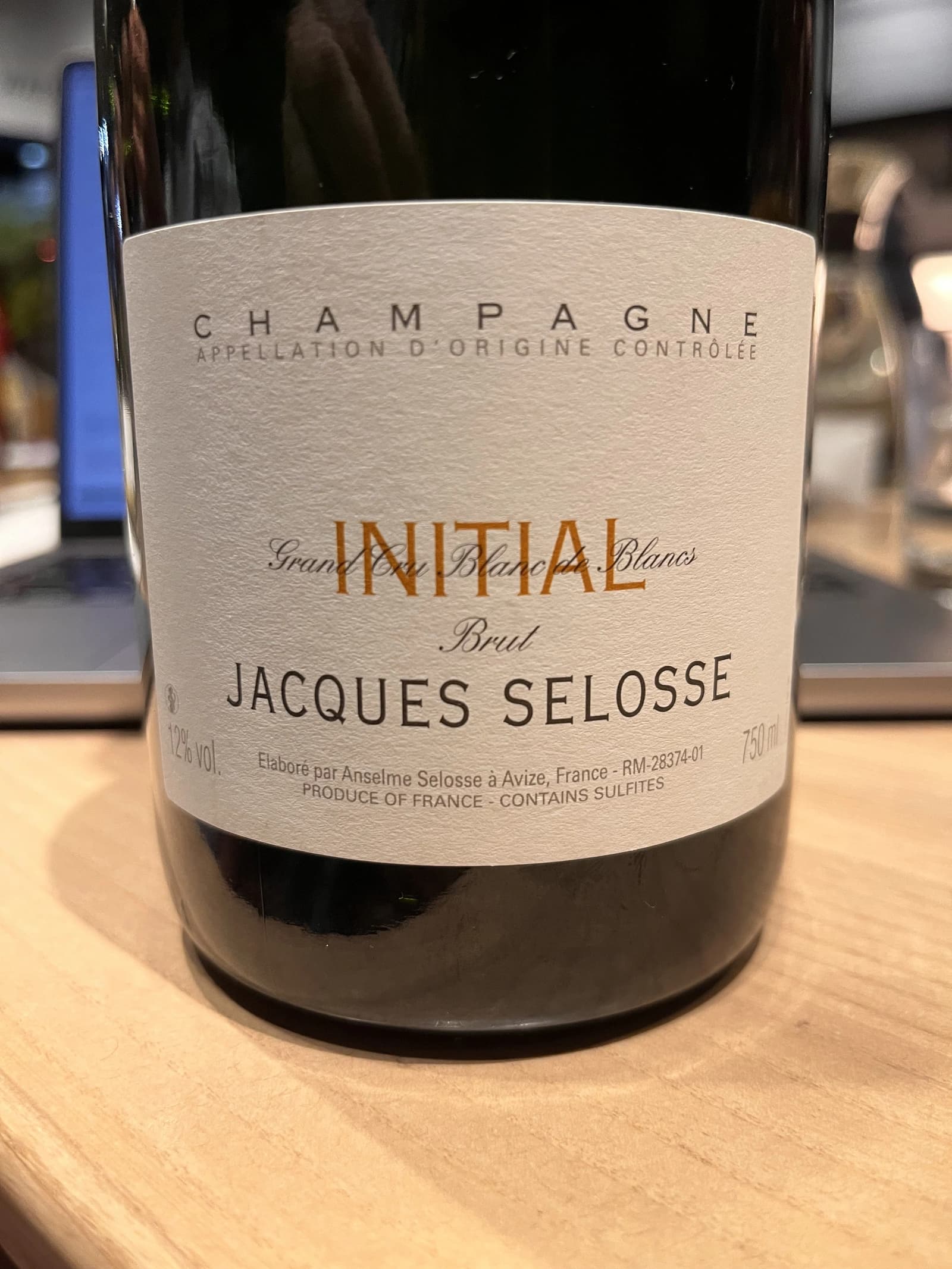
This wine secured the 🏅 7th place in our wine tasting lineup.
Anselme Selosse, a visionary figure in the Champagne world, has left an indelible mark on the region with his innovative approach and profound influence. His journey began in 1974 with his first harvest, marking the start of a transformative era in Champagne. Despite retiring, his legacy continues to shape and inspire contemporary Champagne production.
Selosse's pioneering approach wasn't about being the first grower-bottler in Champagne, as many had preceded him. Instead, it was his philosophy, deeply influenced by his studies in Burgundy, that set him apart. In a region where the focus was traditionally on quantity, Selosse shifted the emphasis drawing inspiration from Burgundy's emphasis on the importance of terroir and the value of quality over quantity.
At his estate in Avize, part of the renowned Côte de Blancs, Selosse oversees close to 8 hectares of predominantly Chardonnay vines. His approach to viticulture and vinification is a blend of empirical observation, trial and error, and deep contemplation. From initially applying principles of agro-biology to later turning towards bio-dynamics and eventually developing his unique system of viticulture, Selosse's methods are adaptive, always in tune with the natural rhythms and needs of the vineyard.
Selosse’s Champagnes are known for their distinctive character, a result of his meticulous vineyard management and innovative cellar techniques. He harvests his grapes later than most, ensuring fully mature fruit that does not require chaptalization. In the cellar, his Burgundian influence is evident in the fermentation processes, using indigenous yeasts and ageing in small oak barrels. This approach results in vinous, concentrated wines that stand out for their intensity and complexity.
Selosse's influence extends beyond his own wines. He has inspired a generation of winemakers in Champagne, encouraging them to break away from regional conventions and follow their unique visions. His approach to minimal intervention, focusing on terroir expression, and his distinct winemaking style, have been a source of inspiration for many in the region.
Moreover, Selosse's philosophical approach to winemaking, inspired by figures like Masanobu Fukuoka, emphasizes a deep respect for nature and a hands-off approach in the vineyard. His belief in non-action, allowing nature to take its course, is reflected in his wines, which are expressions of their terroir and vintage.
As the baton passes to the next generation, with his son Guillaume stepping up, the legacy of Anselme Selosse is set to continue. Guillaume, imbued with the same passion and respect for wine and viticulture, is poised to bring his unique identity to the wines of Domaine Jacques Selosse.
In essence, Anselme Selosse's contribution to Champagne is not just in the bottles he produced but in the paradigm shift he inspired in the region. His wines, embodying the essence of their terroir and crafted with an artist’s touch, continue to be highly sought after. His approach, blending deep respect for nature with a Burgundian influence, has redefined the potential of Champagne, making him a revered and influential figure in the world of wine.
Bollinger La Grande Année Rosé 2002
- Region
- France » Champagne » Champagne AOC
- Type
- rose traditional sparkling, brut
- Producer
- Vintage
- 2002
- Disgorged
- 2010-07
- On lees
- ~84 months
- Grapes
- Pinot Noir, Chardonnay
- Alcohol
- 12
- Volume
- 750 mL
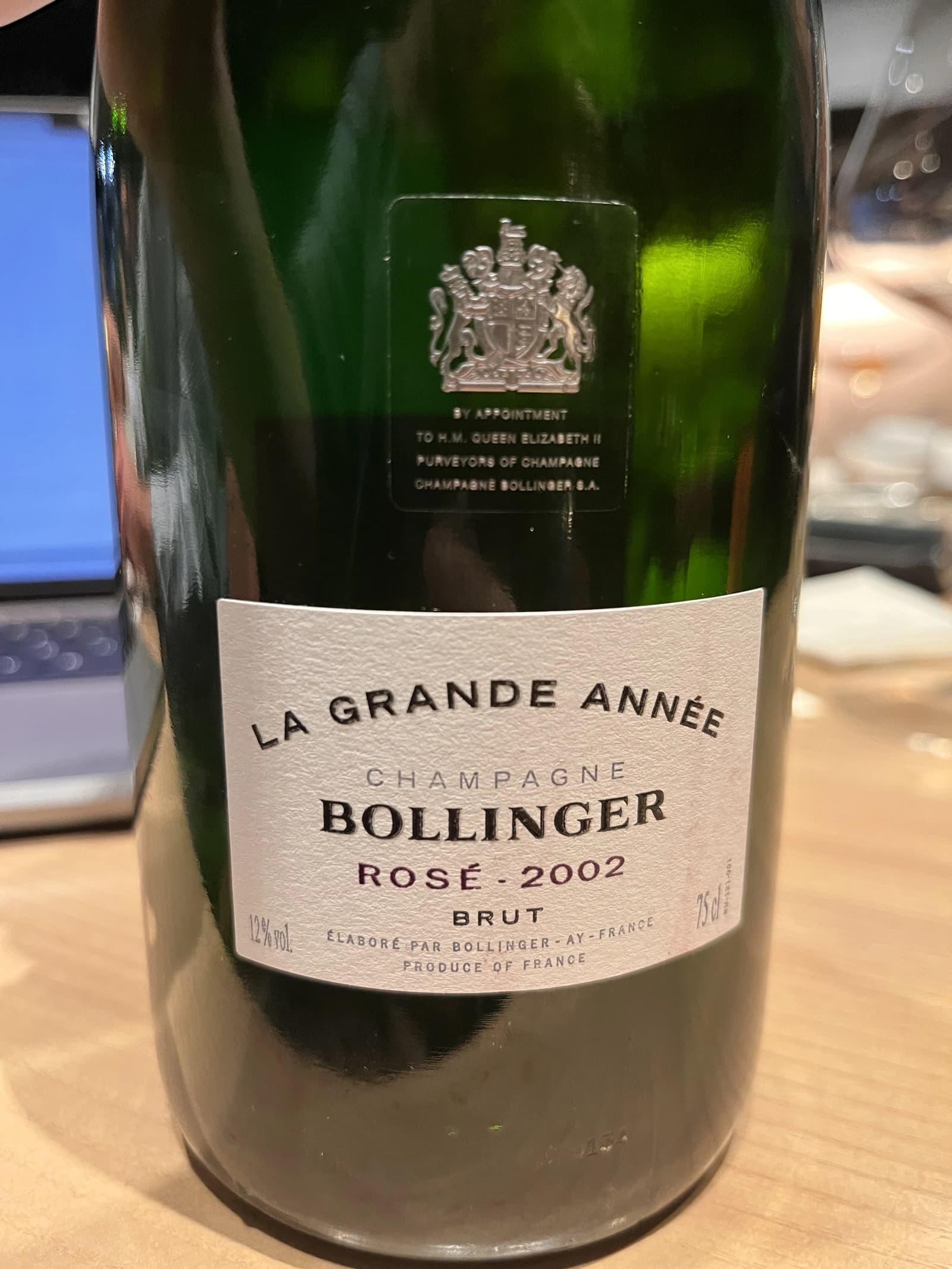
This wine secured the 🏅 9th place in our wine tasting lineup.
Bollinger, a renowned French Champagne house, has been a symbol of luxury sparkling wines since its establishment in 1829 in Aÿ, France. Founded by Hennequin de Villermont, Paul Renaudin, and Jacques Bollinger, it remains one of the few independent Champagne houses, continuously managed by the Bollinger family since 1889. Bollinger's uniqueness lies in its deep roots in the Champagne region, dating back to 1585 with the Hennequin family. This storied history, coupled with their commitment to maintaining family management and independence, sets them apart in an industry increasingly dominated by large conglomerates.
Over the years, Bollinger has built its vineyards at the heart of the finest crus in Champagne. Champagne Bollinger’s 179 hectares of vines are made up of 85% Grand and Premier crus and are farmed by teams of growers across 7 separate vineyards: Aÿ, Avenay, Tauxières, Louvois and Verzenay for pinot noir, around the Montagne de Reims, Cuis for chardonnay on the Côte des Blancs and Champvoisy for meunier in the Vallée de la Marne.
Another of Bollinger’s distinctive features are two plots, the Clos Saint-Jacques and Chaudes Terres, which have never succumbed to phylloxera. These ungrafted vines are entirely tended by hand and reproduced using a form of layering called provignage, thereby providing the means to preserve this extraordinary heritage from which the very exclusive Vieilles Vignes Françaises cuvée is produced.
Château d'Yquem Sauternes 2003
- Region
- France » Bordeaux » Sauternes AOC
- Type
- white still, sweet
- Producer
- Wine
- Vintage
- 2003
- Grapes
- Sémillon, Sauvignon Blanc
- Alcohol
- 14
- Volume
- 750 mL

This wine secured the 🥉 3rd place in our wine tasting lineup.
Resources
- France, Champagne: Making Sense of Champagne. William Kelley.
- Stelzer, T. (2019). The Champagne Guide 2020-2021.
- Parr, R., & Mackay, J. (2018). The Sommelier’s Atlas of Taste: A Field Guide to the Great Wines of Europe. Ten Speed Press.
- Roses De Jeanne. Polaner Selections.
- Flavien Nowack. Floraison Selections.
- Champagne Jacquesson.
- Jacquesson. Rare Wine Co.
- Champagne Jacquesson: a new campaign for a vintage champagne house. Autumn/Winter 2023/24 issue of LUX.
- Champagne De Sousa.
- Henri Giraud. Premium Grands Crus.
- Henri Giraud. Baron Francois.
- Agrapart. Polaner Selections.
- Larmandier-Bernier. Polaner Selections.
- Ulysse Collin. Bowler Wine.
- Ulysse Collin. Luis/Dressner.
- Ulysse Collin: The Terroir Movement. The finest bubble.
- Bérêche.
- Bérêche. Sally Hillman.
- Françoise Bedel. European Cellars.
- Champagne Bedel.
- Bruno Paillard.
- Bruno Paillard. Premium Grands Crus.
- Bruno Paillard. Clos des Millésimes.
- Selosse.
- France, Champagne: Anselme Selosse and Champagne’s Artisanal Revolution. William Kelley.